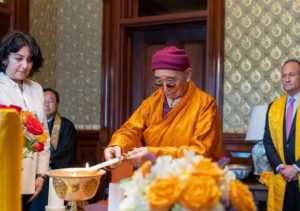
We find ourselves in a world that is not of our making. This body, with its strengths and weaknesses, is also not our free choice. We learn, adapt, reconfigure, but still: here we are, living through strange narratives and storylines, feeling out the complex mixtures of identity and experience amid the madcap goings on of billions of other lives. We are surrounded by a jumbled world of seemingly endless “things,” useful and frivolous, that people have created and superimposed on the natural order—which is itself a wondrous question mark. This is samsara’s fine mess. And sometimes it is messier than expected. There are incidences of pain and suffering that, even if brief, can cast a long shadow that follows us for years or decades. And so we trudge forward through this foreign landscape, our burdens growing heavier as time slips by, with uncertainty and impermanence hardening their existential reign.
Yet this is not a new plight. Great adepts of the past, Buddhist and otherwise, have wrangled mightily with the human condition and come up with some extraordinary escape routes. And in spite of the highly baroque and intricate nature of Tibetan Buddhism, there are some methods that can be adapted to the simplicity and expediency of the modern age. One such compelling technique is actually a preliminary to every extensive ritual of the Higher Yoga class (Anuttara tantra), repeated in a highly formulaic structure. Yet its elaborate nature can be directed to the more yogic lifestyle and brought to bear on our daily travails and traumatic burdens with great effect. We are referring to the practice of Inner Offering, which involves the transformation of a traditional set of “five meats and five nectars” and whose aim is nothing less than the purification of our entire experience in a single brilliant metamorphosis.
Old problem, old solution
A study of the origins and complex nature of the visualizations and mental gymnastics involved with these traditional rituals is highly edifying. For this, the Encyclopedia of Tibetan Signs and Motifs by Robert Beer is an excellent starting point. Here we cut to the chase and present a useful and simple method for reframing our reality at the flip of a switch. The most effective way to use this method is to direct it toward an entire scenario, a multi-factor situation, a city with all its bad memories, a complex relationship and its lingering negativity, a financial bad streak that goes on and on, a family or work situation that is all-encompassing in its dysfunction. All of that is about to be tossed into one big, transforming soup.
We start by seeing the entire container of reality as a gigantic human skull-cup. It should be as large as our capacity to visualize or think about allows—but house-sized will do. This represents the union of mind and experience, of subject and object, the spacious containment field of life as we know it. Within this vast cooking pot are five specific “meats” and five “nectars.” These symbolic items are traditionally “transgressive” from both a cultural and ethical perspective. The five meats are the food sources forbidden to the highest or Brahmin caste of India (horse, cow, dog, elephant, and human flesh). The five nectars are human feces, sperm, marrow (brain), urine, and a certain kind of blood. But in actuality they are stand-ins for the five Buddhist skandhas of mind and the five elements of body. They are the building blocks of our impure experience, of our samsaric, step-down world of confusion, attachment, and aversion. Each one has a seed syllable and each a direction, color, and elemental correspondence. These can certainly be learned and utilized, but that elaboration is not essential. We just need to know that all the components of our physical and mental reality are in there. For our purpose, it is also that damned city, that accursed situation, that trauma that never recedes, those people and scenarios that torment us. We dump it in there as in the form of those meats and nectars, but we can also see pieces and fragments of those experiences jutting out as well. I suggest hitting on one specific issue, although eventually we can throw the whole phantasmagoria of this illusory absurdity called “life” into the skull-cup of transformation.

Now our vast container becomes a cauldron, a crucible, the “athanor” of the alchemists. With the fire of our desire, motivation, intent, and life force, and the wind of our agile, ever-moving mind-stream, we turn the burners on full blast. With or without the magical syllables of Om Ah Hung, we think that all this material begins to cook at high heat: it melts and dissolves, sending out spirally fumes and vapors of our intense aspirations and higher intentions. These waft into the universe, inviting and evoking the highest forms of enlightened energy and conscious good will, in whatever form you conceive these spiritual forces. In turn, our crucible is flooded with energetics of an entirely different order. What we are infusing our grand soup with is what is called jinlab in Tibetan. This is often translated as “blessing,” but literally means “waves of grace,” frequencies of benediction. Let them be Buddhist, Christian, Daoist, Hindu, or otherwise, but let this disastrous mess of samsara be sanctified and revert back to its true nature.
At this point, it is important to think of, to see in the mind’s eye, or to experience directly, the Five Elements in their purified form as five colored lights, luminous patterns of intelligence, information, and world-building. The whole rotten city and its bad memories, the bad people, the dysfunctional situations, the old wounds, are all fabricated of low-level, impure, elemental configurations. We have converted it all into alchemical gold, meaning the Five Wisdoms in their male and female polarities. The yin and yang of existence is seen in its purified pentad arrangement. While this may be a visualization to start with, once we are familiar with the process, it will begin flow on its own, quite naturally. Take time to rest a while with this new state of affairs, experiencing all of that previously tangled karma as now a blissful and pervasive rainbow of elemental playfulness.
Some benefits of this practice are obvious, some less so. It is handy and can be applied anywhere, in any situation, as well as in the privacy of your meditation space. It is designed to fundamentally change how you perceive situations, the world, and yourself within it. With time, this will actually clear karmic entanglements and attachment to old traumas. But what might be unexpected is that is can actually change those physical, real-time situations themselves. If there is an ongoing issue, a dragged out and unresolved conflict or obstacle, doing this practice (even just a little) can at times produce dramatic change. Tantra is, after all, not just a “visualization process” or exercise in imaginative thinking. That approach to the mind’s capacity is very Western/materialist in view, and very erroneous. Mind, when linked to its Wisdom aspect, is immensely powerful. Even mundane intellect has great power, but it must work through actions, words, feelings. The Five Wisdoms work on all these levels of course, but also directly with energy—fundamental energies. They alter the web of information and electromagnetism that is behind events in the physical world. And so there can be fundamental changes in the matrix of our lives, in situations that are normally beyond our reach and range.
Suffering, in its infinite forms, including old age, sickness, and death, is inevitable. The eight worldly dharmas however, (loss and gain, renown and infamy, pleasure and pain, praise and blame) lose their immense hold on us when we have the knowhow to cook their entire narrative in the crucible of the mind’s purity. The five impure elements that compose these storylines are transformed, and we enter a new kind of inner landscape, the tantric distinction that changes everything.
See more
Related features from BDG
Now or Never
Subduing War, Pestilence, Evil, and Fear – The Vajrayana Way
Meeting Reality in Hard Times












